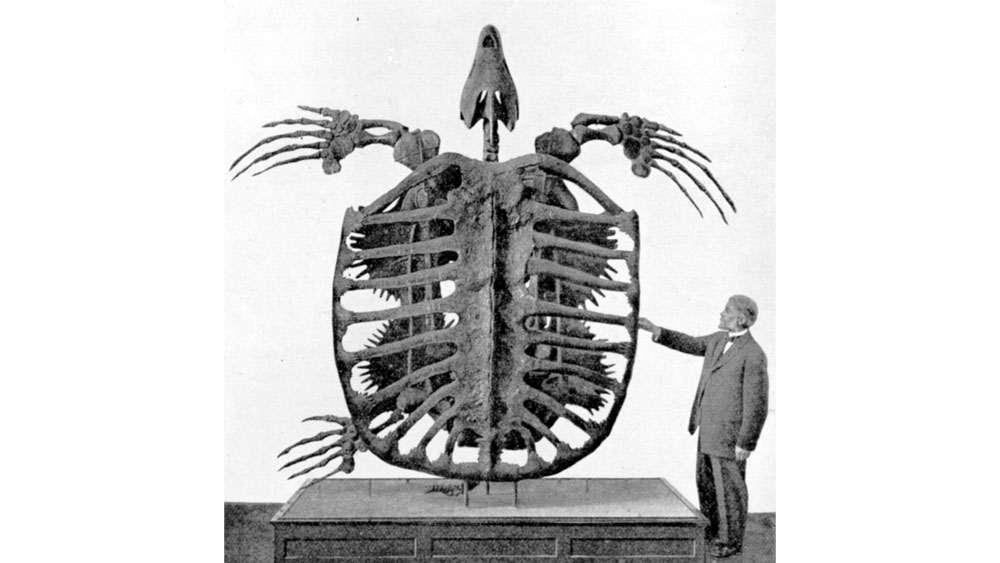Recent evolutionary research is attempting to provide an explanation for why some animals became smaller over time. Or equivalently, it is attempting to explain why some animals of the past were larger. Dr. Shovonlal Roy of the University of Reading and two colleagues performed computer calculations that attempted to simulate the manner in which evolution and natural selection would shape body size due to changing conditions.1,2 Dr. Roy said,
"Just like how we try to adapt to hot or cold weather depending on where we live, our research shows animal size can get bigger or smaller over long periods depending on the habitat or environment. In places and times where there’s lots of competition between different species for food and shelter, animal sizes often get smaller as the species spread out and adapt to the distribution of resources and competitors."1
Animals do adapt to changing conditions. They sometimes become larger or smaller after colonizing an island. They may also become bigger in order to conserve body heat in colder climates. But we have a fundamental disagreement with evolutionists (and even other creationists) as to how they adapt.
Evolutionists claim that adaption occurs as random mutations make some organisms better fitted for their environment, and the less-fit organisms then die off. As the above quote suggests, this is a very cutthroat, survival-of-the-fittest process. This process of natural selection purports to provide a Designer-free explanation for why organisms seem so well suited to their environments. This supposed, random, trial-and-error process requires long periods of time waiting for the “right” random mutation to occur.
In contrast, ICR gives credit to Jesus. He designed organisms with built-in sensors that enable them to detect changes in their environment. Internal genetic programming then allows these organisms to rapidly adapt to these changes in predictable ways. Such adaptation is often too rapid for natural selection to be the correct explanation.3 This design-based paradigm of adaptation is called continuous environmental tracking (CET).4
CET is analogous to an engineered space probe that is programmed to detect and adapt to changes in conditions it may confront after arriving on another planet. Designing a robot that will simply function on another planet requires intelligent design. But making a robot that can also autonomously detect and respond to changing conditions on that planet requires an even higher level of engineering genius. For this reason, a CET view of adaptation gives greater glory to our Creator, the Lord Jesus Christ.
Dr. Roy’s research was prompted by fossil trends that contradict evolutionary expectations. A rule in evolutionary biology called Cope’s Rule states that animals become bigger over time. Yet there are many exceptions to Cope’s Rule.
Most fossils are actually the remains of creatures that perished and were buried in sediment during the global Flood in the days of Noah. Because of their failure to recognize this, evolutionists have no hope of correctly explaining these trends in the fossil record.
Fossils show that many animals in the past were much larger than their modern-day descendants. This past giantism, recorded in rocks dating from the Flood, needs to be explained. Intriguingly, the reduction in body size is recorded in some fossils found in Ice Age deposits, which occurred shortly after the Flood of Noah.5 Although body size trends within the Flood-deposited rocks may seem confusing to evolutionists (due to their incorrect paradigm and the chaos of the Flood), the Ice Age trend in body size reduction is pretty straightforward. At least in the case of mammals, this decrease in body size was apparently worldwide.6
Can the Bible help explain this size reduction? Scripture testifies that human longevity decreased dramatically after the Flood, with lifespans dropping from 900+ years (Genesis 5) to 400+ years (Genesis 11:12–17), dropping again to 200+ years (Genesis 11:18–32), and then finally decreasing to 70–80 years of age (Psalm 90:10). There are theoretical and experimental reasons to link greater longevity to larger adult body sizes.7
Did animal longevity, as well as human longevity, decrease after the Flood? And if so, could the reduction in animal body size recorded in the fossils be indirect evidence of this decline in longevity? And could this decrease in body size and longevity be an example of organisms adapting to a changing post-Flood environment via continuous environmental tracking (CET)?
ICR is aggressively pursuing this line of inquiry.8,9 I presented a paper about how larger past body sizes are a possible indication that animals lived much longer than they do now and about other preliminary evidence for greater longevity in fossil creatures at the International Conference on Creation last summer.7 I am currently examining this preliminary evidence in more detail. A second paper that explores evidence of extreme longevity in Crassostrea fossil oysters has also been published.10 A third paper has been accepted for publication.11
As always, we thank you for your prayers and financial contributions that make this research possible.
References
- University of Reading. Theoretical research offers explanation as to why some animals shrink over time. Phys.org. Posted January 18, 2024 at phys.org, accessed January 18, 2024.
- Roy, S. et al. 2024. Ecological determinants of Cope’s rule and its inverse. Communications Biology. 7 (38).
- Tomkins, J. P. “Adaptive Tracking” in Seasonal Fruit Fly Populations. Creation Science Update. Posted on ICR.org April 21, 2022, accessed January 18, 2024.
- Guliuzza, R. J. 2023. Continuous Environmental Tracking: An Engineering-Based Model of Adaptation. Acts & Facts. 52 (6): 22–23.
- Hebert, J. 2018. The Bible best explains the Ice Age. Acts & Facts. 47 (11): 10–15.
- Davis, S. J. M. 1981. The effects of temperature change and domestication on the body size of Late Pleistocene to Holocene mammals of Israel. Paleobiology. 7 (1): 101–114, especially p. 101.
- Hebert, J. 2023. Allometric and metabolic scaling: Arguments for design . . . and clues to explaining pre-Flood longevity? Proceedings of the International Conference on Creationism. 9: 206–227, article 18.
- Hebert, J. ICR Research is revealing evidence for pre-Flood longevity. Creation Science Update. Posted on ICR.org October 30, 2023, accessed January 18, 2024.
- Hebert, J. 2023. Living to 900? Acts & Facts. 53 (1): 17.
- Hebert, J. et al. 2024. Crassostrea oyster fossils show evidence of extreme longevity. Creation Research Society Quarterly. In press.
- Hebert, J. 2024. Late Pleistocene body size reduction: evidence of a post-Flood decline in longevity? Journal of Creation. In press.
* Dr. Hebert is Research Scientist at the Institute for Creation Research and earned his Ph.D. in physics from the University of Texas at Dallas.




















